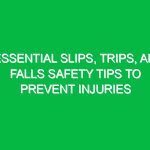Welcome to Today’s Toolbox Talk
Good morning, team! Thank you for gathering for our Toolbox Talk today. Our focus is on a critical aspect of our health, safety, and Environment (HSE) framework: Seatbelt Use and Safety. Whether we’re driving to a job site or moving equipment around the workplace, seatbelts are our first line of defense against serious injury in the event of an accident. Let’s dive into the importance of proper seatbelt use and how we can all contribute to a safer work environment.
Understanding the Importance of Seatbelt Use and Safety
Seatbelts are designed to protect us in the event of a collision. In workplaces where vehicles are used, the risk of accidents is ever-present. According to the National Highway Traffic Safety Administration (NHTSA), seatbelts reduce the risk of death by 45% and the risk of serious injury by 50%. These statistics emphasize that wearing a seatbelt is not just a personal choice—it’s a critical safety measure that can save lives.
The Legal Framework
In many countries, wearing a seatbelt is not only a best practice but also a legal requirement. Regulations vary, but the essence remains the same: compliance with seatbelt laws protects you and others. In our company, we have a strict policy regarding seatbelt use, which aligns with state laws and HSE guidelines. Non-compliance can lead to disciplinary actions and, more importantly, increased risk of injury.
Potential Hazards Associated with Non-Use of Seatbelts
When seatbelts are not used, the risks escalate significantly. Here are some common Hazards:
- Increased risk of ejection from the vehicle during a crash.
- Higher chances of sustaining serious injuries, including head trauma, spinal injuries, and internal injuries.
- Potential legal repercussions and insurance complications following an accident.
Imagine a scenario where a team member decides to take a quick trip in a company vehicle without buckling up. A sudden stop or collision could result in severe consequences—not just for that person but also for the entire team. This is why we must prioritize seatbelt use at all times.
Best Practices for Seatbelt Use and Safety
To ensure we all stay safe on the road, here are some essential Best Practices for seatbelt use:
- Always buckle up: Make it a habit to buckle your seatbelt as soon as you enter a vehicle. This simple action can save your life.
- Check your seatbelt: Before driving, ensure that the seatbelt is functioning correctly. Look for any signs of wear and tear.
- Ensure proper fit: The seatbelt should be snug across your hips and chest. Adjust the seat if necessary to achieve the best fit.
- Lead by example: Encourage your colleagues to wear their seatbelts. A culture of safety starts with each of us.
- Educate others: Share the importance of seatbelt use with new employees and remind existing staff regularly.
Real-Life Examples
Let’s look at some real-life scenarios to reinforce our discussion. A few months ago, a delivery driver was involved in a minor accident. Fortunately, the driver was wearing a seatbelt, which prevented serious injury. The vehicle sustained some damage, but the driver walked away unscathed. In contrast, another case involved a worker who chose not to wear a seatbelt during a transport. The vehicle was hit by another car, and the unbelted worker suffered significant injuries. These stories highlight the critical role that seatbelt use plays in our safety.
Engaging in Discussion
Now, let’s open the floor for discussion. What are some challenges you face regarding seatbelt use? Have you encountered situations that made you rethink your safety practices? Sharing experiences can help all of us understand the importance of Seatbelt Use and Safety better.
Compliance with Company Policies
As part of our commitment to safety, our company adheres to strict policies regarding seatbelt use. These policies are not just regulatory requirements; they are integral to our safety culture. Employees found not wearing their seatbelts may face consequences, including safety Training or disciplinary action. Remember, these policies are in place to protect you and your colleagues.
Training and Resources
To further support our safety initiatives, we offer training sessions that focus on HSE Best Practices, including proper seatbelt use. Please take advantage of these resources, as they are designed to ensure your safety and enhance your knowledge about workplace hazards.
Conclusion: A Collective Responsibility
In conclusion, seatbelt use is a fundamental aspect of Workplace Safety that we must all take seriously. As we’ve discussed, adhering to seatbelt safety not only complies with laws and company policies but is crucial for protecting ourselves and our teammates. It’s not just about individual safety; it’s about fostering a culture of safety that permeates our entire operations.
Thank you all for your commitment to safety and for your participation in today’s Toolbox Talk. Let’s make a conscious effort to always buckle up and promote Seatbelt Use and Safety in our daily operations. Together, we can ensure a safer workplace for everyone.


